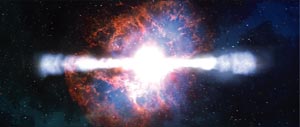The ability of NASA’s Swift satellite to point its X-ray telescope rapidly towards gamma-ray bursts is, for the first time, allowing the study of the afterglow phase a minute or so after the actual burst. The results reveal surprising features not expected from current models of burst mechanisms.

Based on the link between supernovae and gamma-ray bursts (see CERN Courier September 2003 p15), it is now well established that the long gamma-ray bursts, with durations from about 2 s to a few minutes, result from the formation of a black hole in the core collapse of a dying star. Conservation of angular momentum implies that the rotating stellar matter falling onto the newborn black hole will form a very rapidly rotating disc of plasma and generate strong magnetic fields. These are the typical conditions thought to produce relativistic jets perpendicular to the disc, and a gamma-ray burst will be observed if the jet is pointing towards us.
According to this model, spikes in the light curve of the gamma-ray burst correspond to a series of internal shock waves in the jet. Another, single shock wave is expected when the jet interacts with the outer shells of the dying star. This external shock is then responsible for the gradually fading afterglow that lasts for several hours or days after the prompt gamma-ray burst, and is observed at X-ray energies and sometimes down to the lower energies of the optical or even the radio-wave bands.
This simple scenario was sufficient to explain the afterglows observed in X-rays 6-8 h after bursts by missions such as BeppoSAX or XMM-Newton. Now, however, NASA’s Swift spacecraft, launched in November 2004, can slew its X-ray telescope towards a burst within only about a minute of being given its position by the wide-field gamma-ray-burst detector.
The first results published in Nature by G Tagliaferri and collaborators show in most cases a surprisingly rapid initial fading of the X-ray afterglow for several minutes, followed by the usual slower decline lasting several hours. A deeper analysis of two events shows that the X-ray counterpart observed about a minute after the burst is brighter than the extrapolated decline of the prompt emission and has a different spectral shape. It therefore seems that the early X-ray emission is related to the afterglow rather than to the gamma-ray burst itself. Current models are, however, not able to explain easily such a rapid fall-off of the afterglow emission.
This picture is further complicated by the recent detection of X-ray flares in the afterglow of two other gamma-ray bursts observed by Swift (Burrows et al. 2005). An X-ray flare releasing roughly as much energy as the burst itself occurred about 12 min after the gamma-ray burst of 2 May 2005, GRB050502B. Its sharp peak makes it unlikely to be due to an external shock related to the afterglow. It is more likely to be an internal shock resulting from ongoing accretion onto the newborn black hole in the messy environment expected at the heart of a collapsing-exploding dying star.
Further reading
D N Burrows et al. (in press) Science.
G Tagliaferri et al. 2005 Nature 436 985.







